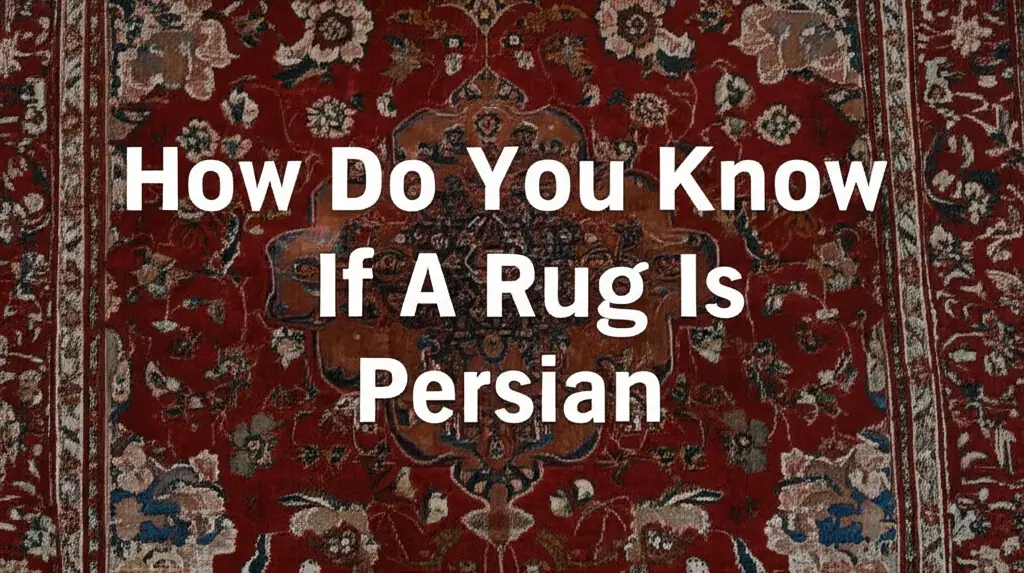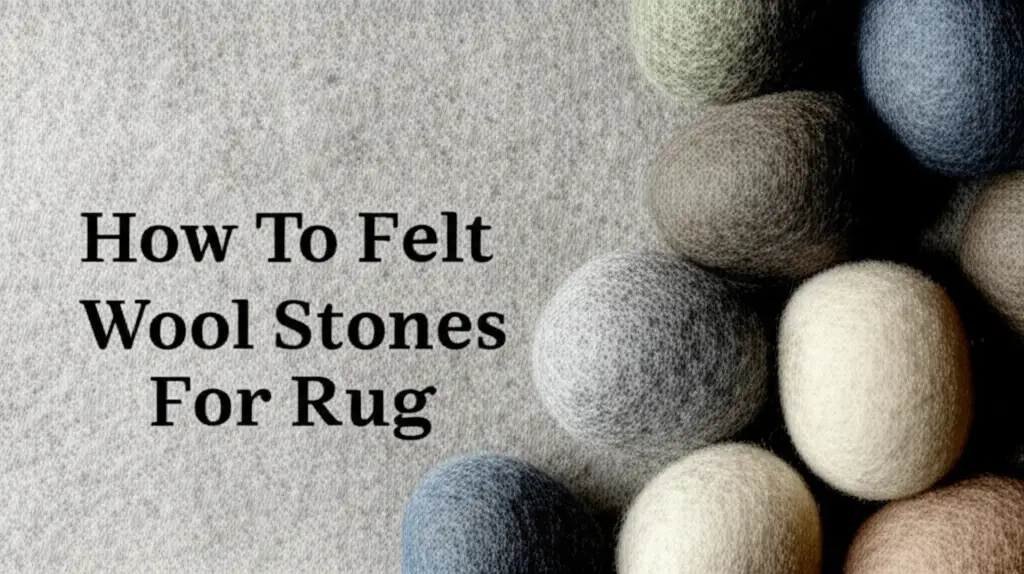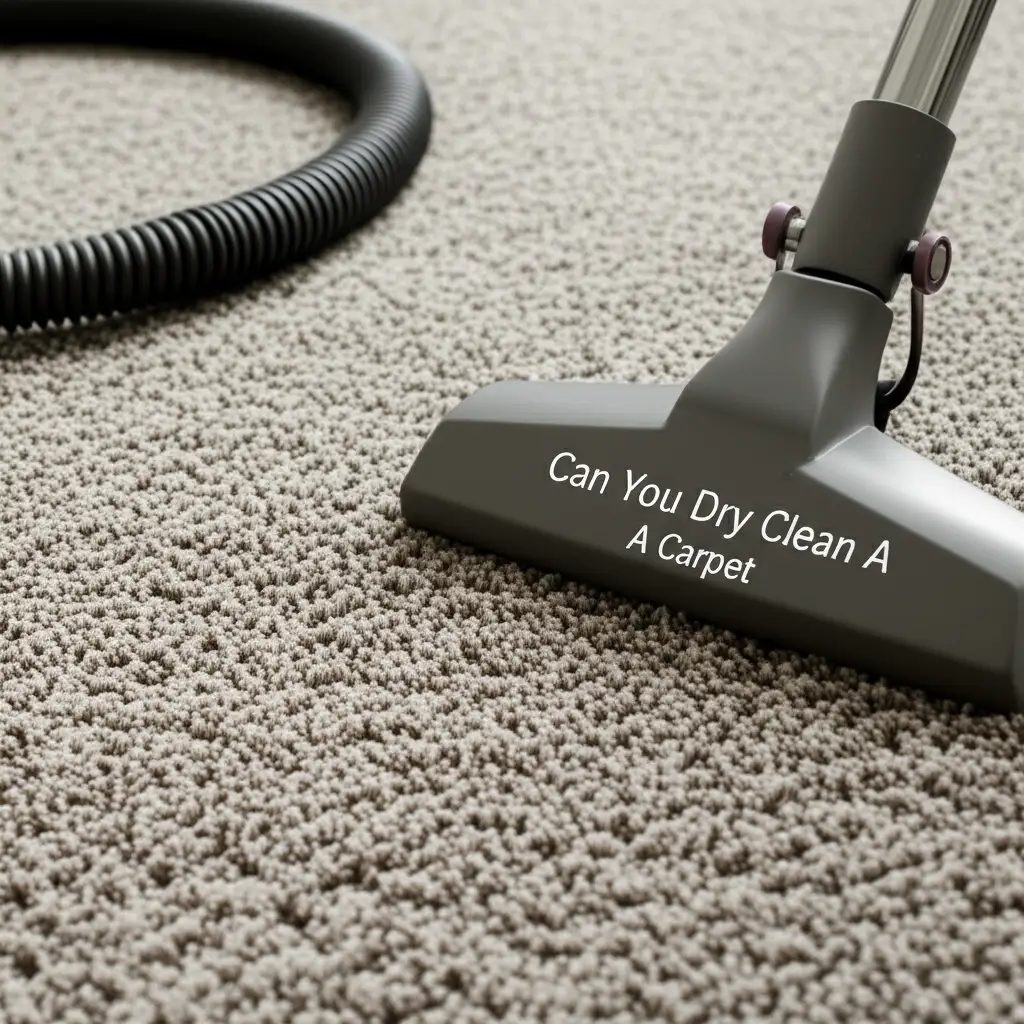· Mason Everett · Home Decor & Rug Care · 17 min read
How Do You Know If A Rug Is Persian

How Do You Know If A Rug Is Persian
Have you ever wondered if that beautiful rug in a store or your home is a genuine Persian rug? Many rugs look similar, but real Persian rugs hold a special place. They have a rich history. They offer unique craftsmanship. Knowing how to identify an authentic Persian rug helps you appreciate its value. It ensures you make a smart investment.
I will guide you through the key features. We will look at construction, materials, dyes, and patterns. By the end, you will understand what makes a Persian rug unique. You can then identify one with confidence. Let’s explore the secrets behind these beautiful floor coverings.
Takeaway
Identifying an authentic Persian rug involves checking several key characteristics:
- Hand-Knotted Construction: True Persian rugs are always hand-knotted, showing irregularities and variations on the back.
- Natural Materials: Expect high-quality wool, silk, or cotton. These materials feel soft and durable.
- Vegetable Dyes: Look for subtle color variations (abrash) and soft, aged tones.
- Unique Designs: Recognize traditional motifs and regional patterns that tell a story.
- Integrated Fringe: The fringe is an extension of the rug’s foundation, not sewn on.
- Expert Consultation: For high-value rugs, a professional appraisal offers final confirmation.
How do you know if a rug is Persian?
You know a rug is Persian by checking its construction, materials, and design. Look for a hand-knotted back with visible irregularities. Feel for natural wool or silk fibers. Observe the natural color variations from vegetable dyes. Recognize traditional patterns and an integrated fringe. These signs point to a true Persian origin.
Examine the Weave: Unveiling the Knot Count and Handcraftsmanship
The way a rug is made tells us much about its origin. Authentic Persian rugs are always hand-knotted. This means skilled artisans tie each knot by hand. This process takes a long time. It results in a unique product. Machine-made rugs cannot replicate this craftsmanship.
Hand-Knotted vs. Machine-Made
You can easily tell the difference by looking at the back of the rug. A hand-knotted rug will have a slightly uneven pattern on the back. You will see individual knots. These knots are often not perfectly uniform. This is a sign of human work. Machine-made rugs, however, have a very uniform and precise pattern on the back. The stitches look perfectly even. Sometimes, you can even see glue or a thick backing material. This type of backing means it is not a hand-knotted rug.
If you bend a hand-knotted rug, you can often see the foundation threads. These are the vertical (warp) and horizontal (weft) threads. The knots are tied around these. This structure makes the rug strong and durable. It allows the rug to last for many generations. A machine-made rug might feel stiffer. It may not bend as easily.
Analyzing Knot Density
Knot density refers to the number of knots per square inch. You can count the knots on the back of the rug. Higher knot density usually means finer detail in the design. It also shows a higher skill level. Persian rugs can have a wide range of knot densities. Some very fine silk rugs have hundreds of knots per square inch. Wool rugs might have fewer, but still significant, counts. A higher knot count does not always mean higher value. It does indicate quality craftsmanship.
Understanding the knot type is also important. Different regions of Persia use specific knot styles. The two main types are the Persian (Senneh) knot and the Turkish (Ghiordes) knot. The Senneh knot is asymmetrical. The Ghiordes knot is symmetrical. An expert can identify these knot types. This helps confirm the rug’s origin. Proper care for such rugs is important. You can learn more about how to clean a handwoven wool rug to keep your rug looking good.
Feel the Fibers: Identifying Authentic Materials
The materials used in a rug are a strong indicator of its authenticity. Real Persian rugs use natural fibers. These materials are durable and beautiful. They feel good to the touch. The quality of these materials directly impacts the rug’s feel and longevity.
The Quality of Wool
Most traditional Persian rugs are made from wool. The best wool comes from live sheep. This wool is rich in lanolin. Lanolin makes the wool strong and naturally stain-resistant. High-quality wool feels soft and springy. If you press your hand into the pile, it should bounce back. Lesser quality wool might feel rough or dull. It might not have the same resilience.
Persian wool often has a unique luster. This glow comes from the lanolin and how the fibers reflect light. You can test wool quality by rubbing the pile. It should feel warm and soft. If it feels cold or stiff, it might be a synthetic blend. Remember, even wool rugs need proper cleaning. You can read about how do you clean an area wool rug for tips.
Silk and Cotton Foundations
While wool is common for the pile, silk is also used for very fine Persian rugs. Silk rugs are incredibly soft and lustrous. They often have extremely high knot counts. A genuine silk Persian rug will feel very smooth and cool to the touch. It will shimmer as light hits it from different angles. Be careful with “art silk” or rayon. These synthetic materials mimic silk but lack its durability and feel. They often feel colder and less fluid.
Cotton is typically used for the foundation (warp and weft) threads. These threads form the base onto which the knots are tied. Cotton foundations make the rug stable. They prevent stretching or shrinking. You can see the cotton threads on the back of the rug. They usually appear as white or off-white lines. Sometimes, wool or silk can also be used for the foundation in specific regional rugs. The consistency of these foundation lines on the back is another sign of hand-knotted work.
Inspect the Colors: Natural Dyes and Their Patina
The colors in a Persian rug tell a story. They reveal the rug’s age and origin. Traditional Persian rugs use natural dyes. These dyes come from plants, insects, and minerals. They create beautiful and lasting colors. Synthetic dyes came later. They often look different.
Vegetable Dyes vs. Chemical Dyes
Natural dyes have a certain depth. They look richer than chemical dyes. Over time, natural dyes develop a beautiful patina. The colors might soften. They might change slightly with exposure to light. This aging process adds to the rug’s beauty and value. Chemical dyes, on the other hand, often look brighter. They can appear more uniform. They may also fade quickly or unevenly.
To tell the difference, look closely at the individual fibers. With natural dyes, you might see slight variations in color along a single strand of wool. This is because the wool absorbed the dye unevenly. Chemical dyes coat the fiber more uniformly. You can also rub a damp white cloth on a small, inconspicuous part of the rug. If a lot of color transfers, it might be a new rug with unstable chemical dyes. Older, naturally dyed rugs generally do not bleed much color.
Color Consistency and Abrash
One strong sign of natural dyes is called “abrash.” This term refers to subtle color variations within a single color field. For example, a large blue area might have slightly lighter or darker stripes of blue. This happens because the artisan used different dye batches. Or, the dye absorption varied during the process. Abrash is not a flaw. It is a sign of authenticity and handcraftsmanship. It adds character to the rug.
Machine-made rugs or those with chemical dyes rarely show abrash. Their colors are typically uniform throughout. The way colors interact is also important. Traditional Persian rugs use specific color palettes. These palettes are often tied to the region where the rug was made. You might see deep reds, rich blues, and earthy browns. These colors are harmonious. They create a visually appealing balance.
Decipher the Designs: Patterns and Regional Motifs
Persian rugs are famous for their intricate designs. These patterns are more than just decoration. They carry cultural meaning. They often reflect the history and traditions of the specific region or tribe that made the rug. Learning about these motifs helps you identify a Persian rug. It also helps you understand its story.
Common Persian Motifs
Persian rug designs often feature floral elements, geometric shapes, and medallions. Common floral motifs include vines, palmettes, and rosettes. These patterns symbolize nature. They represent growth and beauty. Geometric designs are often found in tribal or nomadic rugs. These patterns can include diamonds, stars, or hexagons. They are simpler but still full of meaning.
A central medallion is a very common feature. This is a large, often elaborate, design in the middle of the rug. It can be round, oval, or star-shaped. Sometimes, smaller medallions surround the main one. The corners of the rug often have complementary designs. These are called spandrels. They match or echo parts of the medallion.
You might also see animal figures or human figures. These are less common. When present, they often tell a narrative. They are usually found in older or more collectible pieces. The use of certain animals, like lions or birds, can have symbolic meanings. These details add to the rug’s uniqueness.
Regional Differences in Design
Different regions of Persia (modern-day Iran) have distinct design styles. For example:
- Isfahan rugs are known for their high knot count. They often have intricate floral patterns. They feature a central medallion. The colors are elegant, usually ivory, blue, and red.
- Tabriz rugs are very diverse. They can have medallions, all-over patterns, or pictorial scenes. They are known for their fine weaving and precise details.
- Kerman rugs often feature lush floral patterns. They have a softer, pastel color palette. Sometimes, they show figural designs.
- Shiraz rugs are tribal. They have geometric patterns. They use bold colors. They might include animal or human figures. These rugs often feel more rustic.
- Heriz rugs have a distinct geometric medallion. Their corners are angular. They use strong reds, blues, and browns. These rugs are very durable.
The overall symmetry or asymmetry of the design can also give clues. City rugs are usually very symmetrical. Tribal rugs can be more asymmetrical. This is because nomads weave on portable looms. These looms make perfect symmetry harder to achieve. The design should look hand-drawn, not printed. This means there might be tiny imperfections. These small differences confirm it is not machine-made.
Check the Fringe and Backing: Signs of True Origin
The fringe and the back of the rug offer vital clues. These parts reveal how the rug was constructed. They can help you determine if a rug is truly Persian. Many people overlook these details, but they are very important.
Integrated Fringe
A real Persian rug has an integrated fringe. This means the fringe is part of the rug’s foundation. The vertical threads (warp threads) extend from the rug’s body. They form the fringe. This is the hallmark of a hand-knotted rug. You should be able to see these threads running through the rug’s structure.
If the fringe looks sewn on, then the rug is not a genuine hand-knotted Persian rug. Machine-made rugs or tufted rugs often have fringes glued or stitched onto the ends. Sometimes, a rug might be old. Its original fringe could be damaged. A repair person might replace it. However, if the entire fringe is clearly an added component, it is a sign of a mass-produced rug. Examine the area where the fringe meets the rug. It should be continuous. It should flow directly from the rug’s design.
The Back of the Rug
The back of a Persian rug is as important as its front. You should be able to see the individual knots. They will form a mirror image of the front design. The pattern will be clear. The colors will be vibrant. You might also notice slight variations in knot size or alignment. These imperfections confirm it is handmade. A machine-made rug’s back will look very uniform. The stitches will be precise and perfectly spaced.
You should also look for a selvedge. This is the finished edge along the sides of the rug. On hand-knotted rugs, the selvedge is typically overcast by hand with wool or cotton. It might be slightly uneven. This contrasts with a machine-stitched edge on a factory-made rug. The flexibility of the rug is another sign. A hand-knotted Persian rug is flexible. You can fold it easily. A machine-made rug is often stiff. It may have a thick, rigid backing. This makes it hard to fold. The feel of the back can also provide clues. It should feel somewhat soft and irregular.
Assess the Age and Condition: Vintage vs. Antique Persian Rugs
The age and condition of a Persian rug can impact its value. They also offer more signs of authenticity. Understanding the difference between vintage and antique is important. These terms describe a rug’s age. They also suggest certain characteristics.
Patina and Wear
An older Persian rug will show signs of age. This is called patina. Patina is a natural result of time and use. It includes subtle fading of colors. It can also involve slight wear on the pile. The colors will look softer. The texture might feel more supple. These changes add character. They show the rug has lived a life. However, excessive wear or damage can reduce value. Look for even wear. If wear is only in one spot, it might be from poor placement.
Vintage rugs are typically 40 to 99 years old. Antique rugs are 100 years or older. Both can be very valuable. A genuine antique Persian rug will show consistent wear across its surface. This wear should not look artificial. Some modern rugs are distressed to look old. These will often have artificial wear marks. They may also have uniform fading. A truly old rug will have natural variations. The pile might be lower in high-traffic areas. The foundation might be visible in some spots. This natural aging is hard to fake. Proper care is key for older rugs. Learning how to clean a vantage wool rug can help preserve its beauty.
Value Considerations
The value of a Persian rug depends on many factors. These include age, condition, knot density, material quality, and artistic merit. A well-preserved antique Persian rug can be worth a lot. Even a good quality vintage rug holds significant value. The origin region also plays a role. Certain regions are famous for producing highly prized rugs.
Be wary of rugs that claim to be antique but show no signs of age. Also, inspect for repairs. Well-done repairs can maintain value. Poor repairs can decrease it. Minor wear is often acceptable. It is part of the rug’s history. Major damage can be a concern. When buying, always ask about the rug’s history. Ask about its origin and age. A reputable dealer will provide this information. They will be transparent about the rug’s condition.
Consult an Expert: When to Seek Professional Guidance
Identifying a genuine Persian rug can be challenging. Many fakes and imitations exist. Sometimes, even with all the knowledge, you might feel unsure. This is when seeking professional help becomes essential. Experts have specialized knowledge. They can confirm authenticity. They can also assess value.
Appraisers and Dealers
A professional rug appraiser can tell you if your rug is Persian. They can also estimate its market value. Appraisers examine all the details we discussed. They look at the knots, materials, dyes, and design. They use their experience to identify the rug’s origin. They can often tell the specific region or even the workshop. An appraisal report provides a documented assessment. This report is useful for insurance purposes. It is also helpful if you plan to sell the rug.
Reputable rug dealers are another good resource. They often have deep knowledge of Persian rugs. They can share insights about a rug’s characteristics. Many dealers offer authentication services. They want to maintain their reputation. They will be honest about what they sell. Ask for their credentials. Ask how long they have been in business. Look for dealers specializing in hand-knotted rugs. They can explain the nuances of different weaving styles. Remember, even genuine Persian rugs need professional cleaning over time. Consider services for where to get persian rugs cleaned in fort worth to if you live in that area.
Avoiding Fakes
The market has many rugs that look like Persian rugs but are not. These might be machine-made imitations. They might be hand-knotted but from other countries. Some places produce rugs that mimic Persian designs. These rugs are not fake in themselves. They are just not Persian. The issue arises when they are sold as Persian.
To avoid fakes, always buy from a trusted source. Ask questions. Be skeptical of deals that seem too good to be true. Understand that a genuine hand-knotted Persian rug requires significant labor. This means it will have a certain price point. A very cheap “Persian” rug is likely not authentic. Use the tips from this article. Look for the signs of handcraftsmanship. If you are making a significant investment, a professional opinion is always wise. It protects your investment. It ensures you get a true piece of art.
FAQ Section
Q1: Can a machine-made rug look like a Persian rug? Yes, machine-made rugs can mimic Persian designs. They often copy traditional patterns and colors. However, they lack the irregularities of hand-knotted rugs. Their fringes are usually sewn on, not integrated. The back of the rug will appear very uniform and perfectly stitched.
Q2: Are all hand-knotted rugs Persian? No, not all hand-knotted rugs are Persian. Hand-knotted rugs are made in many countries, including Turkey, India, China, and Pakistan. These are often called Oriental rugs. Persian rugs are a specific type of Oriental rug, originating from Iran. Their patterns and weaving styles are distinct to Iranian regions.
Q3: How much do real Persian rugs cost? The cost of a real Persian rug varies greatly. It depends on factors like age, condition, knot density, materials (wool vs. silk), and size. A small, new wool Persian rug might cost a few hundred dollars. Large, antique silk rugs with high knot counts can cost tens of thousands. Quality and authenticity influence price.
Q4: What is abrash? Abrash refers to the subtle color variations within a single color field on a rug. This creates a striped or banded effect. It occurs because natural dyes were used from different batches, or the wool absorbed the dye unevenly. Abrash is a desirable feature. It shows the rug is hand-dyed and authentic.
Q5: How do I care for my Persian rug? Caring for a Persian rug involves regular gentle vacuuming. You should also rotate it every year for even wear. Avoid direct sunlight to prevent fading. For spills, blot them immediately. Professional cleaning every few years is essential. This helps preserve the fibers and colors. Always use a professional experienced with hand-knotted rugs.
Conclusion
Identifying a genuine Persian rug involves looking at several key features. You need to inspect its hand-knotted construction. You should feel its natural materials, like wool or silk. Observe the unique characteristics of natural dyes, such as abrash. Recognize the traditional and regional patterns. Always check for an integrated fringe. These elements combine to tell the rug’s true story.
Knowing how to determine if a rug is Persian helps you appreciate its rich history and value. These rugs are more than just floor coverings. They are works of art. They represent centuries of craftsmanship. By using these identification tips, you can confidently distinguish an authentic piece. Owning a Persian rug is owning a piece of history. Protect your investment by understanding its unique qualities and caring for it properly. Enjoy the beauty and heritage your genuine Persian rug brings to your home.





